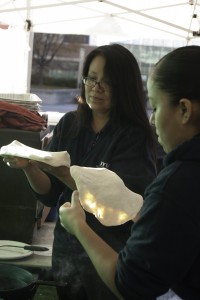The Navajo population has increased by 25 percent since 2008 within The Church of Jesus Christ of Latter-day Saints. The surge stems in part from a communal gardening program started by Larry Justice, stake president in the Tuba City Arizona Stake, the New York Times reported.

“Their grandparents knew how to farm. Their parents forgot it. We’re working to make sure the young people learn it,” Justice told the New York Times.
Two years ago the First Presidency of the Church met with Ben Shelly, president of Navajo Nation, to discuss the challenges and opportunities facing the Navajos and what the Church can do to help.
Robert Sutters, a junior studying at BYU, is half Navajo and lived on the reservation when he was young.
“Living on the reservation is totally different,” he said. “I had friends growing up who didn’t have running water or electricity. It’s like a different world that people don’t understand.”
Sutters explained that the crime, domestic violence and mortality rates are very different on the reservations compared to other areas of the country.
“Those kids go through so much more than anywhere else,” he said. “Life there is three times harder than any inner-city ghetto. People just do not realize that.”
However, he said it is the difficult life on a reservation that helps the people there find hope through the gospel of Jesus Christ.
Bronte Sam lived on a Navajo reservation before moving to Provo when she was 8 years old. She now regularly returns to the reservation to visit extended family still living there.
“I have seen the influence of the Church and the influence that it has had overall on the reservation and it does lower the amount of domestic violence,” she said.
Sam’s parents joined the church as youth while living with LDS families in Utah. Many young American Indians were sent to live with LDS families in order to receive a good education as part of the Indian Placement program. The program began in 1947 and ended in 2000.
Although both of her parents are Navajo, Sam’s family left the reservation and moved to Provo when she was in grade school and has lived here ever since.
“I count it as a blessing because I grew up in the Church,” Sam said.
Sutter’s mom is also a convert to the Church and met the missionaries while living on the reservation.
“It’s such a hard environment (living on the reservation),” Sutters said. “It’s a desert and it is literally a harsh environment where life shouldn’t be flourishing. I look at my mom and the missionaries who converted her when she was a little girl. I look at all those blessings and see all the blessings that gospel is bringing to these people. It’s completely different. It definitely helps and makes you reflect on the blessings and opportunities we do have.”
Brad Corbett, a student at BYU, served in the Arizona Tempe Mission where he spent time on a reservation.
He said that although there are many Navajos listed as members on church records, many of them are not actively coming to church. He explained that for many, it’s difficult to leave behind some cultural norms in order to remain active in the Church.
“The retention rate is horrible,” he said. “It’s hard to break tradition for religion.”
However, many on the reservation are embracing the LDS Church and the standards and principles associated with being a member. Sam said she recognizes the blessings the gospel has given her and is consequently grateful for the opportunity she has at BYU.
“I’m getting an education to help myself in hopes to help the rest of my community and the Navajo people,” she said. Sam is studying exercise science and hopes to help with medical care on the reservation after graduation.




